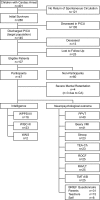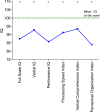Long-term neuropsychological outcomes in children and adolescents after cardiac arrest
- PMID: 25894622
- PMCID: PMC4477720
- DOI: 10.1007/s00134-015-3789-y
Long-term neuropsychological outcomes in children and adolescents after cardiac arrest
Abstract
Purpose: Research into neuropsychological functioning of survivors of cardiac arrest (CA) in childhood is scarce. We sought to assess long-term neuropsychological functioning in children and adolescents surviving CA.
Methods: Neuropsychological follow-up study involving all consecutive children surviving CA between January 2002 and December 2011. Intelligence (IQ), language, attention, memory, visual-spatial, and executive functioning were assessed with internationally validated, neuropsychological tests and questionnaires. Scores were compared with Dutch normative data.
Results: Of 107 eligible children, 47 who visited the outpatient clinic (median follow-up interval: 5.6 years) were analyzed. Fifty-five percent had an in-hospital CA, 86% a non-shockable rhythm, and 49% a respiratory-related etiology. CA survivors scored significantly worse on full-scale IQ (mean = 87.3), verbal IQ (mean = 92.7), performance IQ (mean = 85.6), verbal comprehension index (mean = 93.4), perceptual organization index (mean = 83.8), and processing speed index (mean = 91.1), than the norm population (mean IQ = 100). On neuropsychological tests, compared with norms, respectively adjusted for IQ, significantly worse scores were found on visual memory, significantly better on verbal memory (recognition), and comparable outcomes on visual-motor integration, attention, other measures of verbal memory, and executive functioning. On questionnaires, parents reported better executive functioning than the norm, but teachers reported more problems in planning/organizing skills.
Conclusions: Long-term neuropsychological assessment of CA survivors showed significant weaknesses, but also relatively intact functioning. As deficits in IQ, memory and executive functioning have significant impact on the child, long-term follow-up and neuropsychological support of CA survivors is warranted.
Figures



Comment in
-
Neuropsychologic outcomes from paediatric cardiac arrest: an important step forward.Intensive Care Med. 2015 Jul;41(7):1307-9. doi: 10.1007/s00134-015-3910-2. Epub 2015 Jun 23. Intensive Care Med. 2015. PMID: 26100124 No abstract available.
References
-
- Lopez-Herce J, Del Castillo J, Matamoros M, Canadas S, Rodriguez-Calvo A, Cecchetti C, Rodriguez-Nunez A, Alvarez AC, Iberoamerican Pediatric Cardiac Arrest Study Network R Factors associated with mortality in pediatric in-hospital cardiac arrest: a prospective multicenter multinational observational study. Intensive Care Med. 2013;39:309–318. doi: 10.1007/s00134-012-2709-7. - DOI - PubMed
MeSH terms
LinkOut - more resources
Full Text Sources
Other Literature Sources
Medical
Research Materials

